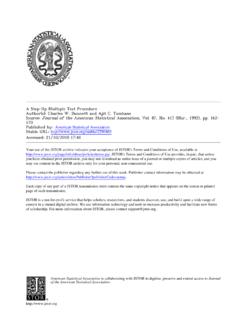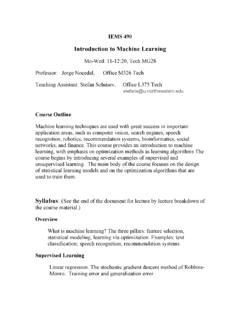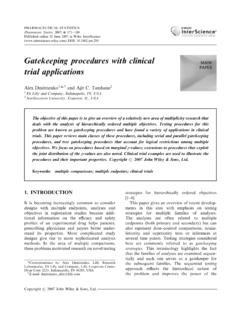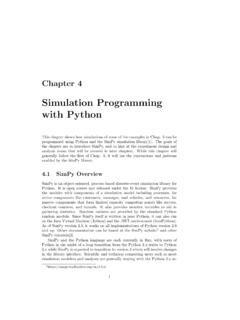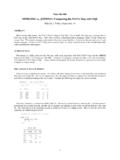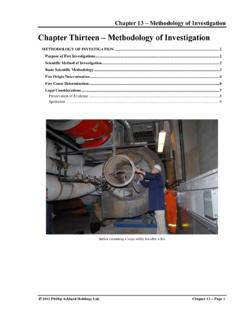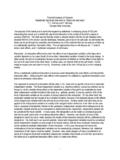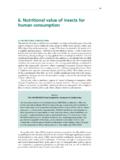Transcription of Step-Up Multiple Testing of Parameters with Unequally ...
1 Step-Up Multiple Testing of Parameters with Unequally correlated EstimatesAuthor(s): Charles W. Dunnett and Ajit C. TamhaneSource: Biometrics, Vol. 51, No. 1 (Mar., 1995), pp. 217-227 Published by: International Biometric SocietyStable URL: : 21/10/2010 18:17 Your use of the JSTOR archive indicates your acceptance of JSTOR's Terms and Conditions of Use, available JSTOR's Terms and Conditions of Use provides, in part, that unlessyou have obtained prior permission, you may not download an entire issue of a journal or Multiple copies of articles, and youmay use content in the JSTOR archive only for your personal, non-commercial contact the publisher regarding any further use of this work.
2 Publisher contact information may be obtained copy of any part of a JSTOR transmission must contain the same copyright notice that appears on the screen or printedpage of such is a not-for-profit service that helps scholars, researchers, and students discover, use, and build upon a wide range ofcontent in a trusted digital archive. We use information technology and tools to increase productivity and facilitate new formsof scholarship. For more information about JSTOR, please contact Biometric Society is collaborating with JSTOR to digitize, preserve and extend access 51, 217-227 March 1995 Step-Up Multiple Testing of Parameters with Unequally correlated estimates Charles W.
3 Dunnett Department of Mathematics and Statistics and Department of Clinical Epidemiology and Biostatistics, McMaster University, Hamilton, Ontario L8S 4K1, Canada and Ajit C. Tamhane Department of Statistics and Department of Industrial Engineering and Management Sciences, Northwestern University, Evanston IL 60208, SUMMARY We consider the problem of simultaneously Testing k > 2 hypotheses on Parameters 01, .., k using test statistics t1, .. , tk such that a specified familywise error rate a is achieved. Dunnett and Tamhane (1992a) proposed a Step-Up Multiple test procedure, in which Testing starts with the hypothesis corresponding to the least significant test statistic and proceeds towards the most significant, stopping the first time a significant test result is obtained (and rejecting the hypotheses corresponding to that and any remaining test statistics).
4 The parameter estimates used in the t statistics were assumed to be normally distributed with a common variance, which was a known Multiple of an unknown o-2, and known correlations which were equal. In the present article, we show how the procedure can be extended to include Unequally correlated parameter estimates . Unequal correlations occur, for example, in experiments involving comparisons among treatment groups with unequal sample sizes. We also compare the Step-Up and step -down Multiple Testing approaches and discuss applications to some biopharmaceutical Testing problems. 1. Introduction We consider the problem of Testing a set of k > 2 hypotheses H1.
5 , Hk, which are to be considered jointly, rather than separately, because they are related to the same research question. We adopt the criterion that the familywise error rate (FWE), which is the probability of one or more Type I errors occurring, should be <a under any null configuration of the Parameters being tested. The test statistics for Testing the Hi are denoted by ti. We label the hypotheses in order of the statistical significance of the t statistics, so that H1 corresponds to the least significant test statistic and Hk the most significant. Stepwise Testing of the Hi involves comparing the t statistics with a set of critical constants, c1 S * * * S Ck.
6 The Testing is carried out sequentially one hypothesis at a time and either stops or continues to the next hypothesis depending on the result observed for the particular hypothesis tested at that stage. If the Testing is Step-Up , it starts with H1 and proceeds toward Hk, stopping the first time a rejection occurs (and rejecting all remaining hypotheses). If the Testing is step -down, it starts with Hk and proceeds towards H1, stopping the first time an acceptance occurs (and accepting the remaining hypotheses). The Newman-Keuls test is a well-known example of a step -down test. step -down Testing is better known than Step-Up , perhaps because it usually seems more intuitive to test the most significant hypotheses first.
7 However, Step-Up Testing can be advantageous in situations where the experi- menter expects to reject all or nearly all of the Hi. There are some well-known problems in biopharmaceutical Testing where Step-Up Testing should therefore be considered. Two examples are: Key words: Adjusted p values; Biopharmaceutical Testing ; Familywise error rate; Multiple com- parisons with a control; Multivariate t distribution; Simulation-based quantile estimation; Simultaneous inference; Stepwise tests; Unbalanced designs. 217 218 Biometrics, March 1995 (1) Comparing k known active drugs with a placebo for the purpose of Testing the sensitivity of an experiment, where it is expected that each null hypothesis of no difference between a known active drug and placebo will be rejected (see Dunnett and Tamhane (1992b)); (2) Comparing a combination drug with each of its constituents to verify that its efficacy exceeds that of any subcombination, where again it is expected, in order to justify the use of the combination drug, that each null hypothesis of no difference will be rejected (see Snapinn (1987) or Patel (1991)).
8 step -down Testing , on the other hand, is appropriate in comparing a new drug with known standard drugs when the aim is to show, for marketing purposes, that it is superior to at least one of the standard drugs (see Dunnett and Tamhane (1992b)). Two important Step-Up Multiple Testing procedures were proposed recently by Hommel (1988, 1989) and Hochberg (1988) (see also Hochberg and Benjamini (1990)). Both were developed by applying the closure principle to the improved Bonferroni method of Simes (1986) to obtain stepwise Testing procedures for the individual hypotheses. Hochberg's method, which uses the same Bon- ferroni critical points used in the step -down method of Holm (1979), is easier to apply than Hommel's which uses a more complicated algorithm to identify the hypotheses to reject.
9 Both methods are uniformly more powerful than Holm's method, but do not necessarily satisfy the FWE S a requirement for all cases as Holm's method does. They are known to satisfy the FWE requirement for the same cases that Simes' method does, which includes the case of independent test statistics where an analytical proof has been given as well as certain dependence cases for which simulation evidence is available. In Dunnett and Tamhane (1992a), a normal theory based Step-Up procedure (denoted by SU) was developed. To test the hypotheses, it uses t statistics based upon parameter estimates assumed to be equally correlated with correlation coefficient p and with equal variances.
10 For values of p > 0, we have found empirically that the critical values c,, for SU satisfy cm < cm, where cm denotes the Bonferroni constants used in Hochberg's procedure, over the range of values of a studied (namely, .01 < a < .20), except for m = 1 where c1 = c'j. For this reason, SU achieves higher power than Hochberg's method. It also has been shown to have higher power than Hommel's method in a numerical study (see Dunnett and Tamhane (1993)). However, the restriction to equal correlations makes it unsuitable for use in unbalanced data (unequal sample size) situations. One of the purposes of this study is to show how this restriction can be removed.
